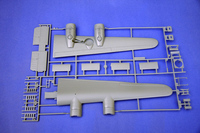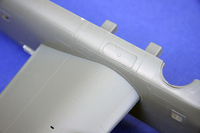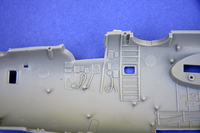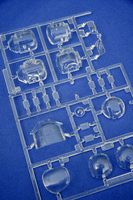I built one of Monogram's 1/48-scale B-24Js when they first came out. That was sometime in the late 1970s if I recall right, soon after the popular reception of its 1/48 B-17G. I built it with no fuss or muss then and the only thing I thought wasn't cool about it were the big seams that went across the tops of the nose and trail turrets but at that time I didn't know much about B-24s and for all I knew, the real ones had seams there too.
A few years later Monogram came out with the B-24D which has a birdcage nose but everything else was about the same as the B-24J. I heard a rumor that Monogram could never re-release the B-24J because it had destroyed the J molds when it created the D version. Well, surprise, Monogram has since re-released its B-24J and one of its newest versions landed in my hands a few weeks ago.
A Historical Side-Step
Pardon me for a moment to write about the real B-24 and not the model. The first Consolidated designed and built B-24 took to the air in 1939. It represented a different type of aircraft design for a big four-engine bomber. For openers, it had what's called tricycle landing gear--the typical main gear found coming down from the wings but instead of a tail wheel which was typical of most aircraft of that time, the B-24 had a nose wheel. The plane sat low to the ground, had a deep boxy fuselage and another unique characteristic--the shoulder-mounted Davis wing which was thin and had low drag qualities. Unfortunately, that also meant the B-24 was not going to handle belly-landings and ditching on water very well nor battle damage. Some crews said it was a brute to fly compared to its fellow American heavy bomber--the Boeing B-17. Although the B-24 flew faster and farther than the B-17 and carried more payload plus more were made, more press was given to the B-17 for various reasons that I'll let others debate. Among the B-24 crewmen who became famous for other exploits were actor Jimmy Stewart, Secretary of the Interior Stuart Udall, South Dakota Governor George McGovern, Secretary of the Treasury Lloyd Bentsen, MASH producer and director Robert Altman, actor Walter Mathau, IBM president Thomas Watson, Jr., author David Westheimer ("Von Ryan's Express") and actor ("Watch Mr. Wizard") Don Herbert who won a Distinguished Flying Cross.
Five plants in the U.S. built 18,482 B-24s, almost 5,500 more than the B-17s. B-24s flew in every theater of WWII for the Americans and they were used by 16 other countries including Great Britain and Australia which called them "Liberators" instead of B-24s. Beside serving as strategic bombers, various modifications of B-24s were used on clandestine missions ferrying spies in and out of enemy territory, photo-reconnaissance missions and electronic counter-measure projects. They also flew as long-range maritime patrol and cargo aircraft and ferried fuel supplies in Europe supporting Patton's 3rd Army and to B-29 bases in China.
Perhaps the most famous air raid associated with the B-24 was the Ploesti mission, "Operation Tidal Wave," on August 1, 1943. Five bomb groups--177 B-24s--under the direction of the Ninth Air Force left their bases near Benghazi, Libya that morning to attack the Ploesti oilfields in Romania which supplied more than a third of the oil products used by the Axis forces. Initially they flew up to 11,000 feet and then descended for a low-level attack. A navigational error resulted in the B-24s hitting the oil complexes from different directions. Countless anti-aircraft guns, augmented by 52 Bf-109 and Bf-110 fighters, protected the oilfields. Coming in low, the B-24s braved the anti-aircraft fire with their gunners sometimes exchanging fire with the anti-aircraft gunners on the ground. Dropping their bombs, they destroyed about 40 percent of the complexes' ability to produce oil however the cost was heavy. Only 88 B-24s returned to Benghazi and of those, only 33 had no damage; one had more than 360 holes in it. At least 44 were lost to the enemy and ditchings on their way home. More than 300 Americans died with another 108 being captured and 78 being interned in neutral Turkey. Five Medals of Honor were awarded to those who fought in this action.
Unfortunately, by September, an analysis of the Ploesti oilfields showed they had recovered totally from the raid and were refining more oil than before.
After the war, practically all B-24s were discarded and today just three remain in flying condition although 14 more are in museums across the world.
Back to the Kit
The sprues are medium-gray styrene plastic and all sprues were in sealed plastic bags the clear sprue was in its own sealed bag. The only loose parts I saw were the two large fuselage halves, and one of the pilots' seats had come loose from its sprue but it was still in its sealed bag.
Yes, this is a repop of the original kit which means it has raised panel lines. Parts are well made with crisp lines and although some flash is visible in places, it's easily trimmed away. In looking for sinkholes, I saw none. As for ejector marks, yes and it looks like all won't be visible once the kit is assembled. The inside of the main landing gear doors have very small ejector marks but, again, those will be hidden once the main gear struts are attached to the doors. Parts have numbers next to them on the sprues although some, like the pilots' seats, have the numbers stamped on them so in a few cases you'll have to do some light sanding to remove those numbers if you're concerned about them.

The Clertrac
If you bought earlier versions of this kit, you know it comes with an MG-1 Cletrac (for Cleveland Tractor Co.), a ground transport tractor used to move aircraft. As with the first version of this kit, the Cletrac is a very simple model of a tracked vehicle with a major drawback--no open areas between the various drive sprockets, support rollers, idler wheels and road wheels. Yup, each set of tracks and wheels, etc. is just one piece with a flat slab of plastic immediately behind the wheels, sprockets rollers and idlers.
I can see armor modelers tearing out their hair at this news--"That's a model of tracked vehicle?!?!?!?" If you want to detail this, you have lots of work to do and you should look at a webpage showing a walk-around of a Cletrac: https://gallery.kitmaker.net/showgallery.php/cat/13737.
Five museums in the U.S., one in Australia and another in the U.K. have Clertracs in their collections including the National Museum of the U.S. Air Force in Ohio, the Heartland Military Museum in Lexington, Neb., and the Pima Air and Space Museum in Tucson, Arizona.
Figures
Also, just like before, the kit has five figures--two ground crewmen, a tractor driver and two pilots, one standing and one to sit in a pilot's seat.
And I imagine with all of those crewmen in in-flight poses, you'll might think to do something else such as building the kit wheels up. However, from my trying to dry-fit the landing gear of the right wing in the up position--keep in mind the kit is designed to be built only wheels down--I can tell you that you have a lot of work ahead of you.
The bomb bay doors, however, can be built open or closed. I almost forgot to mention that the kit comes with six 500-pound bombs and two one-thousand pounders; these represent the normal bomb load for most B-24 missions.
The 16-page directions are straight-forward with colors called out well.
Decals
Both versions that can be built with the decals in this kit are natural metal finish. The decals look very nice and all the colors are in registration. For some time I thought that B-24J's and its similarly-shaped mates, the B-24H and the B-24M, were all natural metal finish. Don't ask me where I got that crazy idea but I have seen plenty of photos showing the typical olive drab over grey camouflage on the J's, H's and M's. So if you want a camouflaged B-24J, you should be able to find some appropriate decals in various forums and on ebay.The Nose and Tail Turrets
Now, the major disappointment with this kit, in my opinion. What's it been since its original release...more than 30 years? Wouldn't one think during all these the years the folks at Monogram and Revell would have heard the masses of B-24 modelers wailing, "Give us some decent nose and tail turrets without seam lines where none were in the original ones!"
Sigh......I guess the Monogram/Revell folks just don't hear. With all the advances in making plastic pieces over the years, I had hoped that there was a way to make clear plastic pieces like those tail and nose gun turrets so they would not have to be pieced together in such a way that seam lines cross the tops of them. So what's one to do?
He not only supplies vacuformed clear pieces but metal guns and other resin pieces too to make complete turrets--50 pieces in all for $25.95 (that's from his Oct. 2011 price list). Because Bill Koster has no website, you need to email him directly for a list of his items and prices: wkoster22@att.net or you can visit this website to see a pdf. of Koster's list from last fall: https://www.swannysmodels.com/images/Koster35/productlist.pdf.
Summation
I feel like I've been writing this piece for those who have seen the previous editions of the kit so let me address those who have not seen this kit before. Is it a good kit? Yes. It assembles easily and goes together well with the typical sanding of seams between the fuselage halves and vertical stabilizers and the upper and lower parts of the wings and horizontal stabilizer. The wings fit into the fuselage halves beautifully and I doubt any filling or sanding will be needed in those places.

Overall, the kit makes up into a nice 1/48 rendition of a B-24J that should look good on a shelf. Thank you to Revell for sending this in to review.


